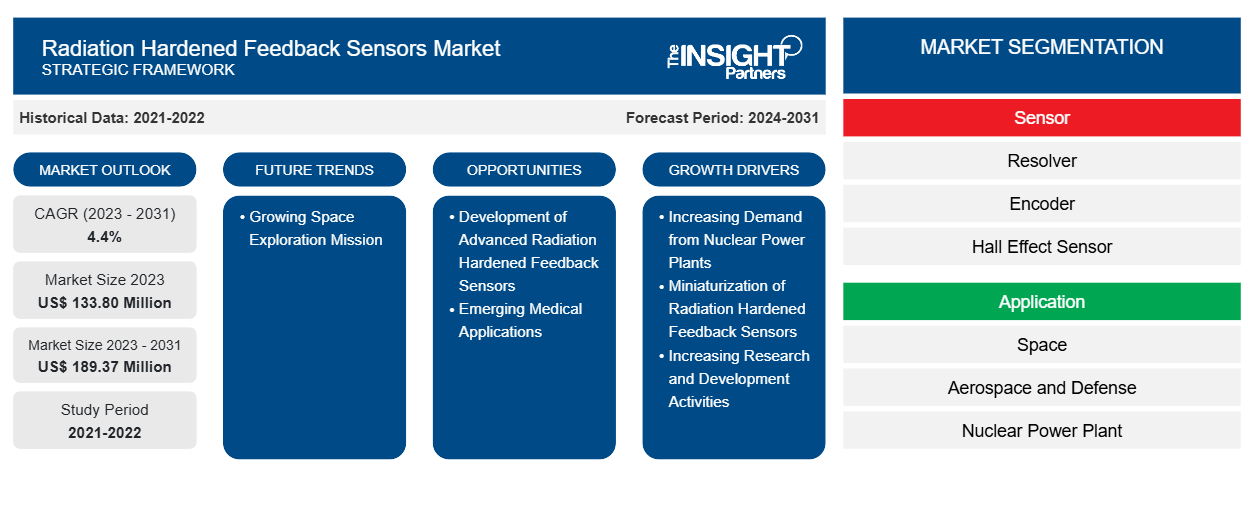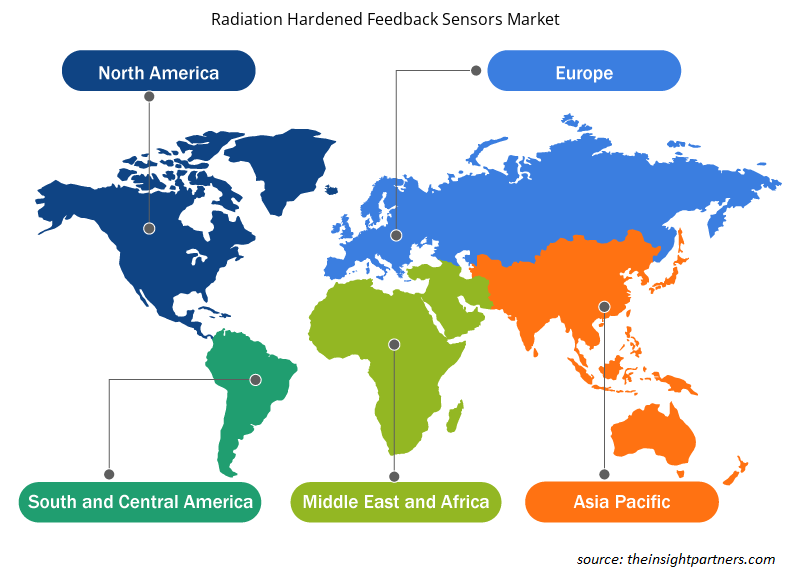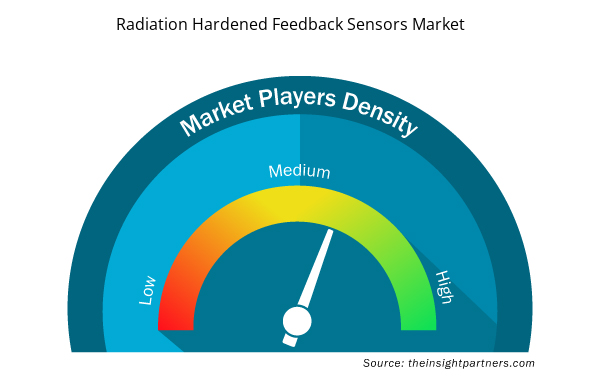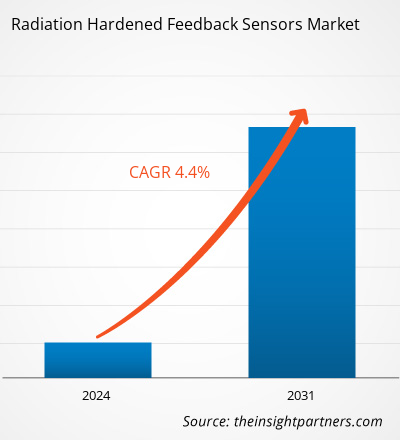The radiation hardened feedback sensors market size is projected to reach US$ 189.37 million by 2031 from US$ 133.80 million in 2023. The market is expected to register a CAGR of 4.4% during 2023–2031.
The growing space exploration mission is likely to remain one of the key radiation hardened feedback sensors market trends.
Radiation Hardened Feedback Sensors Market Analysis
The radiation hardened feedback sensors market forecast is estimated on the basis of various secondary and primary research findings such as key company publications, association data, and databases. Radiation hardened feedback sensors are devices designed to withstand high levels of radiation, most commonly encountered in nuclear and space environments. These sensors employ a feedback mechanism for continuously monitoring their performance and adjust accordingly by ensuring reliable and accurate operations in hard radiations. The sensors utilize feedback loops to detect any deviations from their expected behavior caused by radiation-induced damage. These sensors play a vital role in ensuring the functionality and safety of critical systems in high-radiation applications, such as aerospace and defense, space, satellite communication, and nuclear power plants. A variety of radiation hardened feedback sensors, such as encoders, potentiometers, hall effect sensors, and resolvers, are available in the market.
Radiation Hardened Feedback Sensors Market Overview
Growing demand for radiation hardened feedback sensors among critical equipment and system manufacturers across the globe is expected to boost the radiation hardened feedback sensors market during the forecast period. Radiation hardened feedback sensors are widely integrated into aerospace & defense systems, spacecraft, satellites, space probes, medical equipment, and others. Technological advancements, miniaturization of radiation hardened feedback sensors, rising demand for renewable energy, and increasing R&D activities are propelling the radiation hardened feedback sensors market.
The expansion of the space exploration mission, rising national security, and scientific discoveries also contribute significantly to the expansion of the radiation hardened feedback sensors market size. Operators are highly concerned about maintaining performance and protecting their systems and equipment against hazardous environments. This reflects a high demand for radiation hardened feedback sensor features integrated into spacecraft, satellites, space probes, medical equipment, and other systems.
Customize This Report To Suit Your Requirement
You will get customization on any report - free of charge - including parts of this report, or country-level analysis, Excel Data pack, as well as avail great offers and discounts for start-ups & universities
Radiation Hardened Feedback Sensors Market: Strategic Insights

- Get Top Key Market Trends of this report.This FREE sample will include data analysis, ranging from market trends to estimates and forecasts.
Customize This Report To Suit Your Requirement
You will get customization on any report - free of charge - including parts of this report, or country-level analysis, Excel Data pack, as well as avail great offers and discounts for start-ups & universities
Radiation Hardened Feedback Sensors Market: Strategic Insights

- Get Top Key Market Trends of this report.This FREE sample will include data analysis, ranging from market trends to estimates and forecasts.
Radiation Hardened Feedback Sensors Market Drivers and Opportunities
Miniaturization of Radiation Hardened Feedback Sensors to Favor Market
Miniaturized devices play a crucial role in providing precise measurements under harsh radiation environments. These sensors offer significant benefits such as improved radiation resistance, space-saving, and extended operational lifespan in a wide range of applications—aerospace & defense, space, and nuclear power plants. The primary advantage of miniaturized radiation hardened feedback sensors is their improved efficiency. The reduced size of radiation hardened feedback sensors allows manufacturers to optimize their operational performance, enable faster response times, and provide more accurate readings. This enhanced efficiency of miniaturized radiation hardened feedback sensors is highly beneficial in applications where real-time data acquisition and analysis are critical, such as in particle accelerators and nuclear reactors.
Miniaturization of sensors opens up possibilities to integrate radiation hardened feedback sensors into a wide range of electronic devices such as satellites, nuclear reactors, microcontrollers, radiation therapy or imaging devices, and particle accelerators. The integration of such sensors ensures accurate and reliable measurements in the presence of ionizing radiation. The key players operating in the market are taking several strategic steps, such as partnerships, collaborations, and new product launches. For instance, in March 2020, MACCON GmbH & Co. KG launched DS-16 encoders with only 16mm outside diameter. DS-16 is the new miniature capacitive encoder that provides absolute feedback and is designed to fulfill the needs of medical systems and robotics applications. Thus, the rising demand for miniaturized radiation hardened feedback sensors drives the market.
Development of Advanced Radiation Hardened Feedback Sensors – An Opportunity in Radiation Hardened Feedback Sensors
Advanced radiation hardened feedback sensors are designed to support users to continue their operations in the exposure of high levels of radiation. These sensors offer several benefits to the users or systems operating in harsh environments. The sensors ensure that the critical system receives the proper feedback required to function properly. This reliability is highly essential in spacecraft navigation or nuclear reactor control. Moreover, the development of advanced radiation hardened feedback sensors ensures the safety of critical systems by providing stable and precise feedback in challenging radiation environments.
Radiation hardened feedback sensors are used in numerous applications to ensure the reliability, safety, and longevity of systems operating in the harsh environment. The growing demand for advanced radiation hardened feedback sensors has encouraged manufacturers to develop new innovative sensors or upgrade existing sensors with additional features. For instance, in March 2022, Netzer Precision Position Sensors A.C.S. Ltd. developed and launched a new VLM-60 capacitive multi-turn absolute encoder for harsh environments. The VLM-60 is an electric, non-contact capacitive multi-turn absolute encoder designed for a wide range of demanding tasks in the aerospace & defense, medical, automotive, and robotics industries. This capacitive encoder offers significant benefits to the users, such as being extremely durable and resistant to vibrations and shocks. The low profile, compact, high-density designs and hollow shaft structure provide unparalleled accuracy and resolution encoders, further supporting users in generating precise position or motion feedback for controlling systems in the radioactive environment.
Radiation Hardened Feedback Sensors Market Report Segmentation Analysis
Key segments that contributed to the derivation of the radiation hardened feedback sensors market analysis are sensor and application.
- Based on sensor, the radiation hardened feedback sensors market is divided into resolver, encoder, hall effect sensor, potentiometer, and others. The resolver segment held the largest market share in 2023.
- By application, the market is segmented into space, aerospace and defense, nuclear power plant, and others. The space segment held the largest share of the market in 2023.
Radiation Hardened Feedback Sensors Market Share Analysis by Geography
The geographic scope of the radiation hardened feedback sensors market report is mainly divided into five regions: North America, Asia Pacific, Europe, Middle East & Africa, and South & Central America.
Asia Pacific had the highest growth rate in 2023. Asia Pacific witnessed significant growth in nuclear power in the past and has considerable plans for the construction of more nuclear power plants. China has increased its renewable capacity even though it has lowered its support for renewables through incentives, particularly solar projects. China's National Energy Administration (NEA) announced in 2021 that solar photovoltaic systems are mandatory to be installed on all residential and commercial rooftops. By the end of 2023, solar PV modules are required to be installed on 20% of residential rooftops, 30% of commercial rooftops, 40% of non-government public buildings, and 50% of government buildings. India has also been catching up with the expanding trend of solar panels on rooftops. The Pradhan Mantri Suryodaya Yojana (PMSY) program, introduced by the Indian government in January 2024, aimed to supply rooftop solar (RTS) power systems to 10 million households.
The governments operating in APAC are also developing more nuclear plants. For instance, in February 2023, the Japanese government announced plans to restart nuclear power facilities that had been put on hold when it unveiled the New Basic Energy Plan until 2030, drastically altering the nation's prior nuclear policy. In August 2022, Japan announced its intention to develop and build next-generation nuclear power plants in a major shift from the country's post-Fukushima disaster policy of refraining from the construction of new nuclear plants. The Japanese Ministry of Economy, Trade and Industry (METI) compiled a draft on the construction of new plants, with plans to start commercial operation during the 2030 decade. Further, in January 2024, China's State Council approved the construction of four new nuclear reactors. In nuclear power plants, radiation hardened feedback sensors are widely used in reactor control systems to monitor and regulate key parameters such as neutron flux, reactor power, temperature, pressure, and coolant flow. Therefore, the increasing demand for these sensors in nuclear power plants is propelling the market growth.
Radiation Hardened Feedback Sensors Market News and Recent Developments
The radiation hardened feedback sensors market is evaluated by gathering qualitative and quantitative data post primary and secondary research, which includes important corporate publications, association data, and databases. The following is a list of developments in the market for radiation hardened feedback sensors:
- Dynapar Corporation launched the HS35iQ Encoder with PulseIQ Technology, a new programmable hollow shaft encoder. The HS35iQ Encoder with PulseIQ Technology is a self-diagnosing feedback device with color-coded LEDs and digital output. This device offers a new way for OEM and end users in heavy-duty machine applications to troubleshoot faulty encoders with access to encoder health status in real-time. (Source: Dynapar Corporation, Press Release, 2023)
- EMPIRE MAGNETICS, INC. received a motion control solution provider award from Manufacturing Technologies Insights. The company received an award for manufacturing a wide range of high-quality motor products for its customers. (Source: EMPIRE MAGNETICS, INC., Press Release/Company Website/Newsletter, 2023)
Radiation Hardened Feedback Sensors Market Regional Insights
The regional trends and factors influencing the Radiation Hardened Feedback Sensors Market throughout the forecast period have been thoroughly explained by the analysts at Insight Partners. This section also discusses Radiation Hardened Feedback Sensors Market segments and geography across North America, Europe, Asia Pacific, Middle East and Africa, and South and Central America.

- Get the Regional Specific Data for Radiation Hardened Feedback Sensors Market
Radiation Hardened Feedback Sensors Market Report Scope
| Report Attribute | Details |
|---|---|
| Market size in 2023 | US$ 133.80 Million |
| Market Size by 2031 | US$ 189.37 Million |
| Global CAGR (2023 - 2031) | 4.4% |
| Historical Data | 2021-2022 |
| Forecast period | 2024-2031 |
| Segments Covered |
By Sensor
|
| Regions and Countries Covered | North America
|
| Market leaders and key company profiles |
Radiation Hardened Feedback Sensors Market Players Density: Understanding Its Impact on Business Dynamics
The Radiation Hardened Feedback Sensors Market market is growing rapidly, driven by increasing end-user demand due to factors such as evolving consumer preferences, technological advancements, and greater awareness of the product's benefits. As demand rises, businesses are expanding their offerings, innovating to meet consumer needs, and capitalizing on emerging trends, which further fuels market growth.
Market players density refers to the distribution of firms or companies operating within a particular market or industry. It indicates how many competitors (market players) are present in a given market space relative to its size or total market value.
Major Companies operating in the Radiation Hardened Feedback Sensors Market are:
- TT Electronics
- Magics Technologies nv
- Dynapar
- Power Device Corporation
- NewTek Sensor Solutions
- Netzer Precision Position Sensors A.C.S. Ltd.
Disclaimer: The companies listed above are not ranked in any particular order.

- Get the Radiation Hardened Feedback Sensors Market top key players overview
Radiation Hardened Feedback Sensors Market Report Coverage and Deliverables
The "Radiation Hardened Feedback Sensors Market Size and Forecast (2021–2031)" report provides a detailed analysis of the market, covering the areas given below:
- Radiation Hardened Feedback Sensors Market size and forecast at global, regional, and country levels for all the key market segments covered under the scope
- Market dynamics such as drivers, restraints, and key opportunities
- Radiation Hardened Feedback Sensors Market Trends
- Detailed PEST/Porter's Five Forces and SWOT analysis
- Radiation hardened feedback sensors market analysis covering key market trends, major players, regulations, and recent market developments
- Radiation Hardened Feedback Sensors Industry landscape and competition analysis covering market concentration, heat map analysis, prominent players, and recent developments
- Detailed company profiles
- Historical Analysis (2 Years), Base Year, Forecast (7 Years) with CAGR
- PEST and SWOT Analysis
- Market Size Value / Volume - Global, Regional, Country
- Industry and Competitive Landscape
- Excel Dataset



Report Coverage
Revenue forecast, Company Analysis, Industry landscape, Growth factors, and Trends

Segment Covered
This text is related
to segments covered.

Regional Scope
North America, Europe, Asia Pacific, Middle East & Africa, South & Central America

Country Scope
This text is related
to country scope.
Frequently Asked Questions
The global radiation hardened feedback sensors market was estimated to be US$ 133.80 million in 2023 and is expected to grow at a CAGR of 4.4 % during the forecast period 2024 - 2031.
Increasing demand from nuclear power plants, miniaturization of radiation hardened feedback sensors, and increasing research and development activities are the major factors that propel the global radiation hardened feedback sensors market.
Growing space exploration mission which is anticipated to play a significant role in the global radiation hardened feedback sensors market in the coming years.
The key players holding majority shares in the global radiation hardened feedback sensors market are Hexagon AB, Intertek Group plc, Nikon Metrology, Keyence Corporation, and ZEISS.
The incremental growth expected to be recorded for the global radiation hardened feedback sensors market during the forecast period is US$ 55.57 million.
The global radiation hardened feedback sensors market is expected to reach US$ 189.37 million by 2031.
Trends and growth analysis reports related to Electronics and Semiconductor : READ MORE..
The List of Companies - Radiation Hardened Feedback Sensor Market
- Power Device Corporation
- NewTek Sensor Solutions
- MACCON GmbH & Co. KG
- Honeywell International Inc
- Dynapar Corporation
- EMPIRE MAGNETICS, INC.
- Magics Technologies NV
- Netzer Precision Position Sensors A.C.S. Ltd.
- Computer Conversions Corporation.

 Get Free Sample For
Get Free Sample For